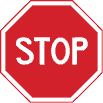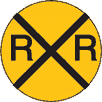RULES OF THE ROAD
(State of Colorado)
7. Rules of the road
7.1. Traffic controls
Traffic controls include traffic signals, traffic signs, and pavement markings. Traffic control also can be provided by law enforcement, highway personnel, or school crossing guards. You must obey directions from these persons.
7.1a TRAFFIC SIGNALS: Traffic signals are lights that tell you when or where to stop and go. Traffic lights are usually at intersections and are red, yellow, and green, from top to bottom. There are intersections and other locations where there are single green, yellow, or red lights. If the traffic signal is not operating or is malfunctioning, treat the intersection as a four way stop.
STEADY RED LIGHT: STOP until a green light appears. After stopping and yielding to pedestrians and other traffic, and if not prohibited by a traffic sign, you may turn right while the light is red. Also, you may turn left on a red light if you are turning from a one-way street onto another one-way street, unless prohibited by a sign.
STEADY YELLOW LIGHT: A red light is about to appear. Stop unless you are already within the intersection.
STEADY GREEN LIGHT: You may proceed straight through or turn right or left unless a sign prohibits such turns. However, you must yield to any vehicle or pedestrian within the intersection or adjacent crosswalk.
GREEN ARROW: A lighted green arrow, by itself or along with a red, green or yellow light means you may make the turn indicated by the arrow. If the green arrow goes off, but the circular green is on, you may still turn after yielding to through vehicles, unless prohibited by a sign or red arrow.
YELLOW ARROW: A lighted red arrow is about to appear. Stop if you are not already in the intersection.
RED ARROW: A lighted red arrow means that you may not proceed in the direction indicated by the arrow.
FLASHING RED LIGHT: A flashing red light means the same as a STOP sign. Stop; then proceed only after yielding to pedestrians and other traffic.
FLASHING YELLOW LIGHT: a flashing yellow light is a warning of a hazard. Slow down and proceed with caution.
7.1b TRAFFIC SIGNS: Traffic signs tell you about traffic rules, hazards, where you are, give directions, and where services are located. The shape and color of these signs give clues to the type of information they provide.
REGULATORY: These signs tell you of laws and regulations that apply at a specific location. They are black or red on a white background. Failure to obey these signs is a traffic violation.
 |
SPEED LIMIT SIGNS: These signs indicate the maximum or minimum safe speed that is allowed. The maximum limits are for ideal conditions and you must reduce your speed when conditions require it. |
|
|
 |
STOP SIGNS: This sign means you must come to a complete stop. Stop at the marked stop line or, if none, at the point just before the intersecting street. If there is a crosswalk, you must come to a complete stop before entering it. You may proceed only after yielding to all pedestrians and vehicles. |
|
|
 |
YIELD SIGNS: This sign indicates drivers must reduce speed or stop if necessary to yield right-of-way to any traffic on the roadway they are crossing or entering. |
WRONG WAY/DO NOT ENTER SIGNS: This sign is used to warn and redirect drivers who are heading the wrong way on one-way streets or freeway ramps. Do not proceed past one of these signs.
 |
 |
ONE WAY SIGNS: Travel only in the direction indicated by the arrow on the sign. |
|
|
|
 |
 |
LANE CONTROL SIGNS: These signs give direction and where you can turn and often use an arrow symbol. The signs are along the road or hanging over the road. Sometimes arrows may be painted on the road. |
|
|
|
 |

|
PROHIBITED SIGNS: These signs indicate you cannot do something, for example, no left turn, or no U-turn. |
|
|
|
 |
 |
PASSING SIGNS: These signs tell you where it is safe to pass another vehicle and where you cannot. Passing areas are based on how far you can see ahead. Where it is permitted to pass, you may do so only if it is safe. |
WARNING SIGNS: These signs are yellow or fluorescent green with black symbols and most are diamond shaped. They warn you to slow down and be prepared to stop if may warn of intersections, different types of highways, traffic entering your area, curves, etc.

ADVISORY SPEED SIGNS: These cautionary signs show the safe speed around curves, corners, and off-ramps.

|
 |
ADVISORY SPEED SIGNS: These cautionary signs show the safe speed around curves, corners, and off-ramps. |
|
|
|
 |
 |
RAILROAD CROSSINGS: Many railroad crossings have signs or signals to warn drivers. Never try to beat a train across the tracks. Never start to cross the tracks until there is enough room for your vehicle to clear the tracks on the other side. Do not shift gears when crossing the railroad tracks in case your vehicle stalls. |
WORK ZONE SIGNS: These signs have an orange background with black letters or symbols. They are used with other traffic control devices or flag persons to help direct traffic safely through work areas and to protect highway workers.
 |
 |
GUIDE SIGNS: These signs have a green background and provide directional and mileage information to specific destinations. |
|
|
|
 |
 |
SERVICE SIGNS: These signs have blue backgrounds and provide directions to service facilities. Signs with brown backgrounds indicate recreational, historic or cultural areas. |
 |
SLOW MOVING VEHICLE: A reflective orange triangle on the rear of a vehicle means it is designed to travel at speeds less than 25 m.p.h.. |
|
|
 |
HANDICAPPED PARKING SIGNS - These signs mark special parking areas for only those vehicles displaying a disabled parking permit. Handicapped parking indicators may also appear on the pavement in designated parking spaces. Crosshatched sections are for van access, only, and parking is not allowed at any time. It is a class B traffic offense, subject to a $100 fine, if you park in a handicapped space without authorization. |
7.1c PAVEMENT MARKINGS: Lines and symbols on the roadway divide lanes, tell you when you may pass other vehicles or change lanes, which lanes to use for turns, define pedestrian walkways, and mark where you must stop for traffic signals or signs.
YELLOW LINES: Separate traffic moving in opposite directions.
- Broken Yellow Line: Drive on the right side of the road and pass with care.
- Solid Yellow Lines: Means a NO-Passing Zone.
- Double Solid Yellow Lines: Neither side can pass.
- Solid & Broken Yellow Lines: You may not pass if the solid yellow line is on your side. If the broken yellow line is on your side, you may pass if it is safe to do so.
You may cross a solid yellow line for a left turn into an alley, private road or driveway when such movement can be made safely.
WHITE LINES: Separate lanes of traffic moving in the same direction.
- Broken White Line: You may change lanes if it is safe to do so.
- Solid White Line: Requires you to stay within the lane and also marks the shoulder of the roadway.
CROSSWALKS: Crosswalks define the area where pedestrians are to cross the roadway. They exist whether the lines are marked or unmarked. You must stop behind the crosswalk to allow any pedestrians to cross (See right of way). Whenever you approach any vehicle from the rear that is stopped at a crosswalk, you may not pass that vehicle.
7.1d LANE CONTROLS: As a rule you must drive your vehicle on the right half of the road. Use only one lane, do not straddle lanes. On roadways without designated bicycle lanes, bicycles are generally required to stay to the far right side of the right lane. They may use the entire lane to pass another vehicle, avoid objects in the road, and turn left. |
 |
|
|
RESTRICTED LANE: One or more lanes may be restricted for special use. Restricted lanes are marked by signs or pavement markings stating that the lane is restricted for special use. There will be a white diamond painted on the road within the lane, and/or a sign posted at the side of the road which specifies its use. Examples are transit, bus, or bicycle lanes. |

|
HIGH OCCUPANCY VEHICLE (HOV) LANE: These lanes are identified by a white diamond painted on the roadway, signs will identify the types of vehicles and the number of occupants required per vehicle to use the lane.
REVERSIBLE LANE: Some travel lanes are designed to carry traffic in one direction at certain times and in the opposite direction at other times. These lanes are separated by a barrier or marked by double-broken yellow lines. There may be signs posted by the side of the road or overhead. Sometimes special lights are used. |

|
SHARED CENTER TURN LANE: These center lanes are reserved for turning and are used by vehicles traveling in both directions. You may turn into or from the road using this lane. You may stop in this lane until it is safe to complete the turn. When a street has a shared center turn lane, you may not turn left from any other lane. This lane is not to be used to pass another vehicle.
UNMARKED LANE: When there are no signs or pavement markings to control the use of lanes, there are rules that indicate which lane is to be used.
- Drive just to the right of the center of the road.
- Do not drive on the shoulder of the road.
- The same rules for passing and turning on marked roads apply with unmarked roads.

























